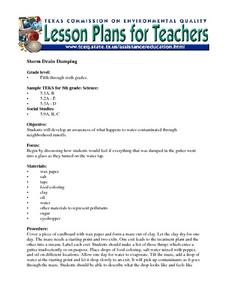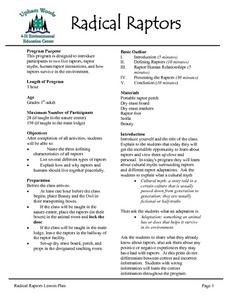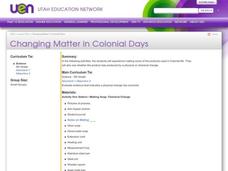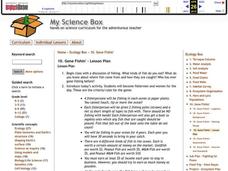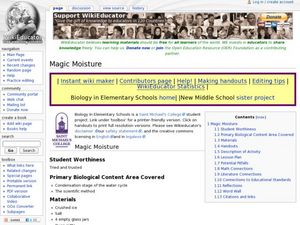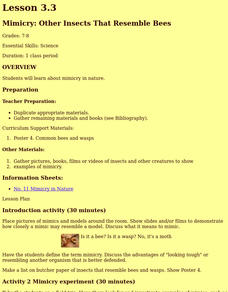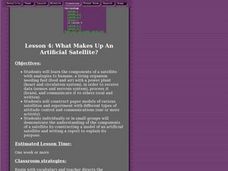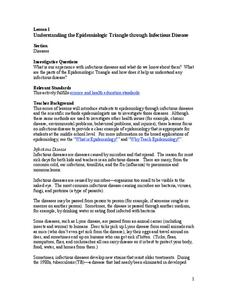Curated OER
Chemical Changes
Second graders investigate chemical changes and reactions and will identify four characteristics that indicate a chemical change. In this chemical change lesson plan, 2nd graders perform experiments that promote chemical changes. They...
Curated OER
Storm Drain Dumping
Students conduct an experiment to show how water gets contaminated through neighborhood runoffs.
Curated OER
Texas Estuary Project
Students take a field trip to a local estuary and analyze water samples. They analyze and graph the data results, write an essay, and create a food web of their field site.
Curated OER
The Conceptual Theory of Chromatography
Students conduct a lab to determine the best way to separate a variety of mixtures choosing between paper, thin layer and column chromatography. They use chromatography techniques to identify unknown substances and submit a lab report on...
Curated OER
Agriculture is a Cycle
What do a bicycle and the life cycle have in common? Cover this and more with the series of cross-curricular activities included in this plan. Learners do everything from making bracelets that represent the life cycle to checking out the...
Curated OER
A Priceless Collection
Students read about and discuss life of Russian geneticist Nikolai Vavilov, define terms related to field of genetics, complete worksheets, conduct seed experiments, observe and record results, and locate seed banks on world map or globe.
Curated OER
Genetic Engineering
Students are introduced to the concept of genetic engineering. In groups, they participate in a variety of experiments, in which they analyze the effect of chemicals on different substances. Using the internet, they research gossypol,...
Curated OER
Edible Rock Layers
Students use edible food items to conduct an experiment that simulates the movement, folding, and faulting of rock strata like sandstone, siltstone, limestone, and shale. Students then get to eat the experiment when completed.
Curated OER
Magnets, Electromagnets, and Motors
Students investigate the concepts of magnetism and its properties. They construct a magnet and test foods for iron content. Then students define the use of a motor and make their own electric motor while working in small groups. Then...
Curated OER
The Floating Golf Ball
Students explore density by floating golf balls. They explore having their golf balls float halfway in a container of water and discuss density and its realtionship to where the golf balls are floating. After adding food coloring, they...
Curated OER
Radical Raptors
Pupils are introduced to raptors and their role in the environment. They identify three characteristics of raptors and list several types of raptors found in nature. They discuss their positive and negative experiences with raptors and...
Curated OER
Making Plastic
Students experiment to create a plastic solution. In this science instructional activity, students use sodium borax and polyvinyl alcohol to create their solution, then identify, discuss, and chart observations on the end product.
Curated OER
Colonial Life
Fifth graders explore American colonial life. In this interdisciplinary history and science lesson, 5th graders participate in several hands-on activities that require them to make colonial products that involve physical or chemical...
Curated OER
Gone Fishin'
Students experiment with population management in this hands-on lesson. In this biology lesson, students collect data on overuse of a resource and how to manage for sustainability. Students fish for m&m's using...
Curated OER
Farming in Space
Eighth graders examine the ways that NASA could create space farms, In this space farms lesson students complete an experiment where they grow several plants.
Curated OER
Magic Moisture
Learners discover the process of condensation. In this experimental lesson, students hypothesize and conduct an experiment to determine where the water comes from during condensation.
Curated OER
No Impact Project: Water
Students use the "No Impact Project" to analyze the consumption of water. In this water consumption lesson, students discuss the pros and cons of tap water or bottled water. Students read about chemicals in water and watch a video clip...
Curated OER
Straw Chromatography
Students separate food coloring using liquid chromatography. In this chemistry lesson, students explain the effects of different solvents on the rate of separation.
Curated OER
Mimicry: Other Insects That Resemble Bees
Learners design a conceptual experiment to test whether mimics actually benefit from the fact they resemble other organisms or objects. They define the term mimicry. They focus on insects that resemble bees and wasps.
Curated OER
What Makes Up An Artificial Satellite?
Students discover the components of a satellite using analogies to humans in a class discussion and participate in an activity in which they construct a paper model of a satellites and experiment with different types of attitude control...
Curated OER
Toothpick Worms
Students investigate camouflage. In this science lesson plan, students experience the role of color in camouflage as they complete a hands-on activity.
Curated OER
Understanding the Epidemiologic Triangle through Infectious Disease
Students examine the epidemiologic triangle. In this disease instructional activity, students discuss infectious disease as they study how they spread and discover their families' experiences with them. Students research Internet sites...
Curated OER
Baby Peanut Plants
Science is a subject ripe with opportunities to read informational text. Kids read to learn about peanuts! They read an informational passage, fill out two comprehension worksheets, and then conduct a lab experiment on a peanut. The...
Curated OER
Baleen Whales vs. Toothed Whales
Second graders review mammal characteristics and study two types of whales. In this mammal study lesson, 2nd graders discuss mammals and define their five characteristics. Students complete a whale worksheet and define differences...

